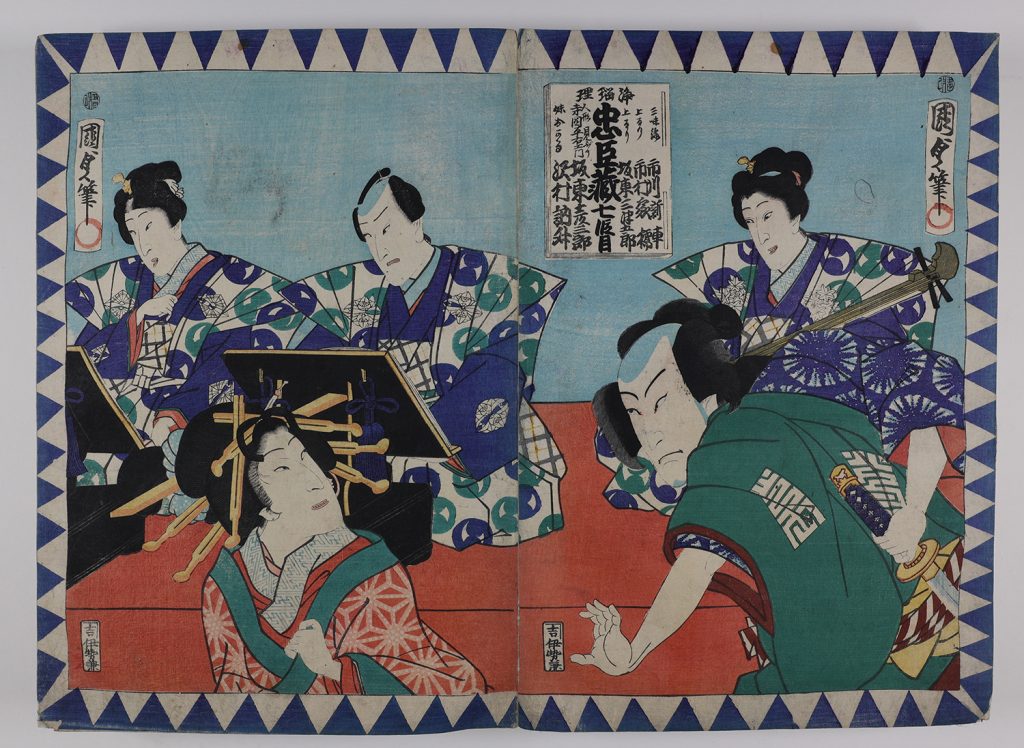Plates 72-73: A Jōruri Performance of The Storehouse of Loyal Retainers, Act VII
Plates 72-73: A Jōruri Performance of The Storehouse of Loyal Retainers, Act VII

Utagawa Kunisada II 歌川国貞 (1823-1880)
A Jōruri Performance of The Storehouse of Loyal Retainers, Act VII (4th month of 1865)
ink and color on paper
Seals:
Publisher: Iseya Kanekichi
Censor: Aratame 丑四改
Engraver: Unknown
Artist: Unknown
Chūshingura 忠臣蔵 (The Treasury of the Loyal Retainers) is one of the most famous and noteworthy kabuki and Japanese puppet play scripts in history. It tells a story of forty-seven rōnin 浪人 (masterless samurai) forming a vendetta and seeking revenge for their previous master. This print depicts the climax of the seventh chapter of Chūshingura. Shown in the foreground of the prints, the main characters here are Heiemon, a foot soldier who wanted to join the vendetta, and Okura, Heiemon’s sister. In this scene, Heiemon is about to draw a sword towards Okura. This conflict originated in previous scenes when Okura accidentally saw the secret letter of Yuranosuke, the leader of the vendetta. Heiemon believes that Yuranosuke would do anything, including killing the witnesses, to guarantee the secrecy of the plan. At the moment depicted, Heiemon decided that he would end his own sister’s life instead of letting a stranger (Yuranosuke) do it.1 This is a huge moral dilemma for Heiemon to choose between the life of his own sister and his loyalty to the head of the vendetta, creating a dramatic effect on the stage. The decorative pattern of blue chevrons surrounding the print often appeared on the clothing of the forty-seven rōnin in kabuki plays and prints.2 As seen in this diptych, it became a prevailing and iconic pattern in depicting the theme of Chūshingura during the Edo period.
These prints incorporate the art form of narrative music, jōruri 浄瑠璃, and the style of Japanese puppet play. “Jōruri” is notated above the main title of this diptych and the names of the depicted narrators and the samisen player in the scene are included to one side of the title, indicating the importance of such roles, with the actors’ names on the other side of the title. The names of the narrators and samisen player are written in the same manner as the main actors, and other contemporary prints reveal that these figures were also professional kabuki actors, indicating the fluidity of the positions in kabuki plays. As the text indicates, the play adopts a special style named ningyō-(mi)buri 人形身振り, namely “(looking like) the moves of puppet.” The kabuki actors mimic the “robotic” movement and gestures one would see in Japanese puppet plays (bunraku 文楽). This fusion of styles blurs the boundary of the two genres as it was a result of adapting the bunraku script into the form of kabuki. This resulting print illustrates well the interesting intersections of cultural practices.
Qihan Gao
Economics, Business, Asian Studies, and History of Art and Architecture
Class of 2022
Annotated Bibliography
Foxwell, Chelsea. “The Double Identity of Chūshingura: Theater and History in Nineteenth-Century Prints.” Impressions no. 26 (2004): 22–43.
This article focuses on the relationships between Chūshingura and 19th-century ukiyo-e prints. The author argues that the ukiyo-e prints and theatre arts developed alongside of each other, evolving through absorption of the new inventions in either genres.
Izumo, Takeda, Miyoshi Shōraku, and Namiki Senryū. Chūshingura (The Treasury of Loyal Retainers) A Puppet Play. Translated by Donald Keene. New York & London: Columbia University Press,1971.
This translation is an accessible and approachable version of Chūshingura.
Izumo, Takeda, Miyoshi Shōraku, and Namiki Senryū. Chūshingura, or The Loyal League. A Japanese Romance. Translated by Frederick V. Dickins. London: Allen & Co., Waterloo Palace, 1930.
This is an earlier translation of the jōruri script of Chūshingura, which presumably has closer relations with this set of prints.
Marks, Andreas. Japanese Woodblock Prints [electronic Resource]: Artists, Publishers, and Masterworks, 1680-1900. Tokyo: Tuttle Pub., 2010.
This book has many examples of Kunisada II’s work with clear identification of publisher and size. On page 150, it has a general introduction of Kunisada II. On page 294, it gives supplemental information about the publisher of this print, Iseya Kanekichi.
